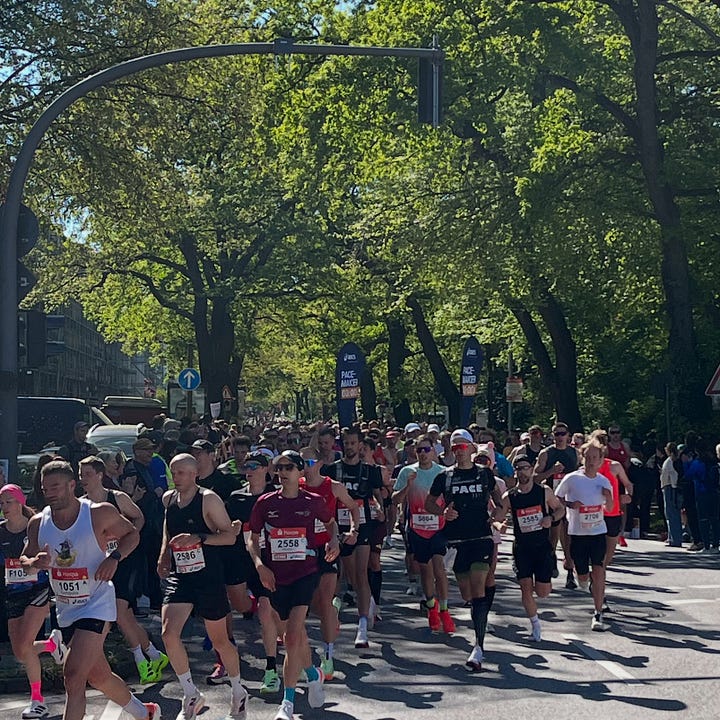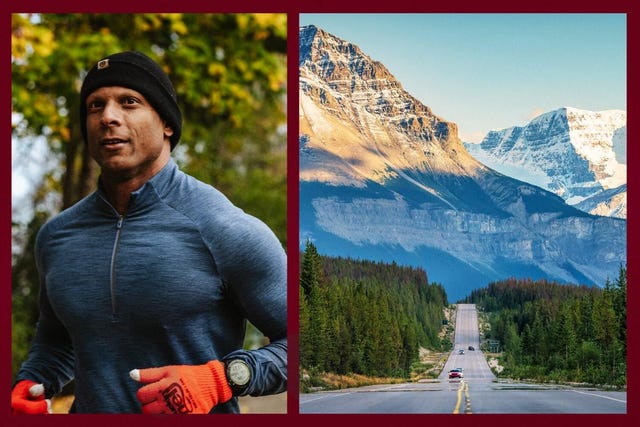Heya and welcome back to Five Things Running!
This weekend was Marathon weekend in Hamburg and 40k runners ran in various races. Our youngest daughter (10) participated in the so called Zehntel (tenth), which was 4.2 km long. On Saturday some 12k kids ran the Zehntel, which shared the same start and finish as the real marathon - and our daughter won her first medal! She was very proud and so was I! On Sunday the Hamburg Marathon took place and it was awesome. The route comes up to my neighborhood at kilometer 22 and then goes around it and comes back at kilometer 32 or so, so my neighborhood was essentially sealed off from traffic, except for some random people trying to find a way out in their cars while the race was underway. I cheered on runners for long enough to get my first sunburn of the year. Of all my cheers, I think that “You’ll get ice cream at the finish!” worked better than “Come on, final sprint!”, probably because the runners knew they were at km 22. Amos Kipruto (Kenia) finished in a new course record of 2:03:46 and Workenesh Edesa (Ethiopia) won in 2:17:55. It’s a fast course with great spectators almost everywhere in the city!


And no, I didn’t run at all. I cleaned the kitchen on Sunday evening and scrubbed the floors. On Monday morning I could hardly move and so I spent another week complaining that I cannot run and feeling miserable. This week will be better!
Here’s this week’s Five Things Running!
The brain has a secret survival trick to endure a marathon
Carlos Matute wasn’t looking for a scientific breakthrough when he laced up his shoes for a long run. But as the miles ticked by, the neuroscientist from the University of the Basque Country found himself chasing a persistent question: “How do we make it to the finish line, being conscious, after having our energy stores depleted?”
That curiosity led to a surprising possible answer. In a recent study in Nature Metabolism, Matute found that myelin—the fatty insulation wrapped about nerve fibers—provides energy when fuel runs low, such as during a grueling endurance event like a marathon. Some headlines have sensationalized the finding as the brain “eating itself,” but Matute says the truth is far more nuanced—and promising. Instead, it adds evidence of how the brain adapts and changes, even well into adulthood.
Let’s start with some science.
How to Train for a Trail Race in a City
More people than ever are dipping their toes into trail races and ultramarathons. In 2024 alone, over 40,000 people completed an ultra for the first time, according to UltraRunning Magazine. But while road marathons are (relatively) predictable—the consistent asphalt surface, unobstructed routes, and regular aid stations—trail races demand a different kind of training. You’ll need to prepare for long climbs, technical terrain, and hours on your feet. Some athletes get caught up in making sure their training environment is as close to race day as possible, so urban-dwelling trail runners might be worried that they could never properly prepare for their long, off-road runs close to home. But it’s totally doable.
Hill-repeats are something I just cannot do in my city. There aren’t any.
Just keep moving
So I found the James River Trail Run in the mountains of Virginia that would give us both the kind of training we needed and also the support of a great running community, which is so helpful during training. One of the reasons I love running races is not so much the competitive aspect with others, but the opportunity to have a great day of training with the support of other runners, and the chance for lots of snacks and drink options. I LOVE training, which I think is such an important part of why I run races. The race is just another day, one that I have been working towards, and of course I hope to have a good day, but also if the day doesn’t go as planned, I hope to still enjoy the journey and learn some things. The race course was a format that I love, especially during training. It was a 10 mile loop that we would run as many times as we’d like in the allotted time. I had decided to go for 3 loops (a 50k distance) and my friend signed up for the same distance, but also knew that it was possible her body might only be ready for 2 loops, and she would be ok with that too. I was convinced that if she took her time she would make it. Just keep moving … forward is a pace.The loop had all the challenges of a good trail race. Some single track, some grassy fields and river trails, some gravel, some big climbs, some smooth downhill running and plenty of roots and rocks to keep it interesting. Each loop had around 1100 feet of elevation, which is definitely a good bit of climbing, especially as the day went on.
what a wonderful way to spend a weekend.
Inside Des Linden’s Final Boston Marathon
After debuting at Boston in 2007, Linden has raced from Hopkinton to Copley Square on Marathon Monday almost every year since—12 times all told—including a bittersweet second-place finish in 2011, an iconic win in 2018 that made her the first American female champion since 1985, and three other top five finishes. In a sport often defined by ups and downs, she’s been remarkably consistent, although Linden isn’t a huge fan of the word.
“Maybe I should have swung bigger and been OK with failing. In order to have a big win, you have to take a big chance, right?” Linden told me a few weeks before the race. “I wonder if I left really good days on the table by being conservative, which looks consistent, but maybe it’s too conservative. If you want an outlier, you have to risk something—but that’s hard.”
Des Linden will focus on trail running, which will be great for the sport.
What It Takes to Run Across Canada in 75 Days
Sachin Latti never set out to become an endurance athlete. But after struggling with depression during the early days of the pandemic — a stretch marked by personal turmoil and professional burnout — the Canadian veteran and former law enforcement officer turned to running as a lifeline. In the process, he discovered something deeper. “Service saved my life,” he says. Running gave him a new way to serve, one that helped him heal while helping countless others.
In just four years, he’s gone from novice jogger to ultramarathoner, using the sport as a vehicle to raise awareness and funds for mental health initiatives across the country. His efforts have already brought in over $80,000 for causes supporting veterans, first responders and addiction recovery.
I’m in awe of these kind of adventures.
I’m grateful for the partners of Five Things Running: Acid Running, New Balance and COROS!
If you missed last week’s edition, you can read it here:
Now, go running!
— Nico
🏃🏻♂️







